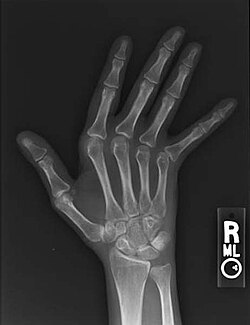| Jaccoud arthropathy | |
|---|---|
| Other names | Jaccoud deformity or Jaccoud's arthopathy |
 | |
| Jaccoud arthropathy seen on a hand x-ray. As opposed to arthropathy due to rheumatoid arthritis, there are no erosions. | |
| Specialty | Rheumatology |
Jaccoud arthropathy (JA), is a chronic non-erosive reversible joint disorder that may occur after repeated bouts of arthritis. [1] [2] It is caused by inflammation of the joint capsule and subsequent fibrotic retraction, causing ulnar deviation of the fingers, through metacarpophalangeal joint (MCP) subluxation, [1] [3] primarily of the ring and little-finger. [3] Joints in the feet, knees and shoulders may also get affected. [1] It is commonly associated with systemic lupus erythematosus (SLE), and occurs in roughly 5% of all cases. [1] [2]
Contents
When associated with rheumatic fever it is also called chronic post–RF arthropathy. [3]